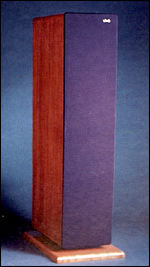I was sitting around today, wishing I was at RMAF with the gang, and doing my usual multitasking thing -- watching the ballgame on TV and fiddling around on the computer. I was thinking about the old Dunlavy speakers where he uses lots of drivers with 1st order acoustic crossovers to get so-called 'transient perfect' response, meaning they will play a square wave and what the mic picks up looks something like a square wave.
The problem with 1st order acoustic slopes is almost no drivers can handle that. I got to thinking about the Duelund concept where you stack 2nd order filters at all the XO frequencies and the ultimate roll-off for most of the drivers is steeper than 2nd order. If you did the same thing with 1st order filters, would the sum still retain its 'transient perfect' behavior?
The answer is YES. Shown below is the theoretical schematic for a 5-way so each driver only has to cover 2 octaves or so. It's just cobbled together with active transfer functions to look at the summed magnitude and phase. Each driver has 4 1st order filters, either highpass or lowpass, all at the same frequencies. Notice that I had to increase the gain of the middle 3 to flatten the response. Once I got the response flat, the phase flattened out and the square wave shaped up.
To build a practical speaker like this, you'd probably need 9 drivers -- W-MW-M-MT-T-MT-M-MW-W. You'd also need a sloped or stepped baffle ala Dunlavy to align the acoustic centers. The big advantage over a Dunlavy would be the steeper acoustic roll-off in the stopband. You might be able to pull it off as a 4-way with the right drivers but I think a 3-way would be pushing it.



The problem with 1st order acoustic slopes is almost no drivers can handle that. I got to thinking about the Duelund concept where you stack 2nd order filters at all the XO frequencies and the ultimate roll-off for most of the drivers is steeper than 2nd order. If you did the same thing with 1st order filters, would the sum still retain its 'transient perfect' behavior?
The answer is YES. Shown below is the theoretical schematic for a 5-way so each driver only has to cover 2 octaves or so. It's just cobbled together with active transfer functions to look at the summed magnitude and phase. Each driver has 4 1st order filters, either highpass or lowpass, all at the same frequencies. Notice that I had to increase the gain of the middle 3 to flatten the response. Once I got the response flat, the phase flattened out and the square wave shaped up.
To build a practical speaker like this, you'd probably need 9 drivers -- W-MW-M-MT-T-MT-M-MW-W. You'd also need a sloped or stepped baffle ala Dunlavy to align the acoustic centers. The big advantage over a Dunlavy would be the steeper acoustic roll-off in the stopband. You might be able to pull it off as a 4-way with the right drivers but I think a 3-way would be pushing it.




Comment